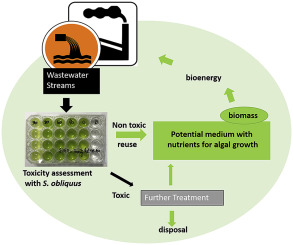Journal of Cleaner Production ( IF 9.7 ) Pub Date : 2018-08-17 , DOI: 10.1016/j.jclepro.2018.08.148 Juliana Abraham , Yanxia Lin , Abhishek RoyChowdhury , Christos Christodoulatos , Matthew Conway , Benjamin Smolinski , Washington Braida

|
The manufacturing of energetic compounds (explosives), such as 1,3,5-trinitroperhydro-1,3,5-triazine (RDX) and 3-nitro-1,2,4-triasol-5-one (NTO), generates large volumes of wastewater containing organic pollutants, which are also rich in nutrients, mainly nitrogen. These wastewaters are subject to regulatory compliance and require treatment prior to their release into local water bodies. An approach is proposed to recover nutrients and water from wastewaters prior to treatment by growing microalgae with the aim to reduce the energy footprint of the munitions production facility by producing algae-based biofuels. In order to assess the feasibility of implementation of the proposed approach, ten different fully characterized untreated wastewaters with various levels of organic and inorganic carbon and nitrogen content were assessed for microalgae toxicity using Scenedesmus obliquus ATCC® 11477 as target microorganism. Toxicity experiments were performed in microplates for six days at 25 °C, 120 rpm orbital mixing speed, under a 14:10 h light: dark photoperiod, and 68 μmol photons/m2s of light intensity. The results indicate that the majority of the wastewater streams assessed could be used as nutrient media with no pretreatment while only three of the streams required chemical treatment due to their high growth inhibition characteristics. From the toxicological results obtained, a site specific mixture prepared by blending of the different untreated waste streams was tested for Scenedesmus obliquus growth. It was observed that this microalga can reach 5 × 107 cells/mL over six days of incubation in the wastewater mixture containing up to 24 mg/L RDX and 28 mg/L NTO. This strain exhibited similar growth patterns in the wastewater mixture as compared to the control sample, suggesting the potential feasibility of using untreated, energetic-laden industrial wastewater along with carbon dioxide [CO2 (atmospheric or flue gases)] for microalgae biomass production.
中文翻译:

用斜生鹿角藻对高能废水流进行藻类毒理学评估和增值
生产高能化合物(炸药),例如1,3,5-trinitroperhydro-1,3,5-triazine(RDX)和3-nitro-1,2,4-triasol-5-one(NTO)大量的废水中含有有机污染物,这些污染物也富含营养素,主要是氮。这些废水必须符合法规要求,并在排放到当地水体之前需要进行处理。提出了一种通过生长微藻从处理前的废水中回收养分和水的方法,目的是通过生产藻类生物燃料来减少弹药生产设施的能源足迹。为了评估实施提议的方法的可行性,斜生栅藻ATCC ® 11477作为靶微生物。在微板中于25:C,120 rpm的轨道混合速度,在14:10 h的光:暗光周期和68μmol光子/ m 2 s的光强度下进行了六天的毒性实验。结果表明,所评估的大多数废水流无需经过预处理即可用作营养培养基,而由于其高生长抑制特性,其中只有三股废水需要化学处理。根据获得的毒理学结果,测试了通过混合不同的未处理废物流而制备的特定位置混合物的斜角藻生长。据观察,这种微藻可以达到5×10 7 在含有高达24 mg / L RDX和28 mg / L NTO的废水混合物中孵育六天后,细胞数/ mL / mL。与对照样品相比,该菌株在废水混合物中表现出相似的生长方式,表明使用未经处理的,充满能量的工业废水以及二氧化碳[CO 2(大气或烟道气)]用于微藻生物质生产的潜在可行性。











































 京公网安备 11010802027423号
京公网安备 11010802027423号